默认情况下,在wpf中,在Avalonia中,样式是中性的,远非总是适合我们需要的任务。 在本文中,我想谈谈使用样式的基础知识,并展示几个有趣的示例。

为什么在Avalonia框架中需要样式?
- 自定义元素时,样式可提供更多自由;
- 不要重复物品说明;
- 分开标记本身及其设计。
几个例子
为了更好地理解样式,请首先看一个示例:
圆形按钮(类似于ubuntu gnome)
为此,请在标准模板(
如何创建模板 )中通过面板集和几个按钮
创建一个简单的布局。
<StackPanel> <Button Margin = "20" Content = "Btn" /> <Button Margin = "20" Content = "Style Btn" /> </StackPanel>
现在我们可以将按钮的主要背景和字体颜色设置为按钮,但是随后我们将不得不重复代码。 风格将有助于避免这种重复。
在窗口中添加适当的样式:
<Window.Styles> <Style Selector = "Button"> <Setter Property = "Foreground" Value = "# FFFFFFFF" /> <Setter Property = "BorderThickness" Value = "2" /> <Setter Property = "Background" Value = "# FFDD4812" /> <Setter Property = "BorderBrush" Value = "# FFFFFFFF" /> </Style> </Window.Styles>
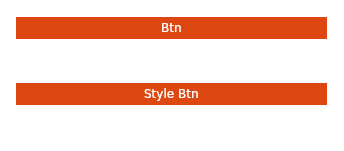
我们得到了类似的东西,但是最好将边缘弄圆。 不幸的是,无论我们如何尝试,都不可能使按钮的边缘变圆,但是您可以使负责显示按钮的模板的边缘变圆。 为此,请添加另一种样式:
<Style Selector = "Button / template / ContentPresenter"> <Setter Property = "CornerRadius" Value = "10" /> </Style>

原来几乎类似,但是有一个问题-将鼠标悬停在按钮上时,会出现一个灰色框(来自标准样式的问候)。

为此,请转到
css :pointerover伪类并添加另一种样式:
<Style Selector = "Button: pointerover / template / ContentPresenter"> <Setter Property = "BorderBrush" Value = "# FFDD4812" /> </Style>
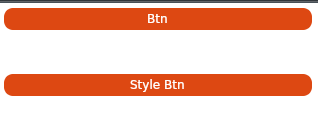
好多了。
但是,如果我只想将样式应用于特定按钮怎么办?
在模板中再添加一个按钮,并将
Classes属性设置为我们要“装饰”的按钮。
<StackPanel> <Button Margin = "20" Content = "Btn" /> <Button Margin = "20" Classes = "btn" Content = "Style Btn" /> <Button Margin = "20" Classes = "btn" Content = "Style Btn" /> </StackPanel>
我们将指示仅影响某些类的样式:
<Style Selector = "Button.btn / template / ContentPresenter"> <Setter Property = "CornerRadius" Value = "10" /> </Style> <Style Selector = "Button.btn"> <Setter Property = "Foreground" Value = "# FFFFFFFF" /> <Setter Property = "BorderThickness" Value = "2" /> <Setter Property = "Background" Value = "# FFDD4812" /> <Setter Property = "BorderBrush" Value = "# FFFFFFFF" /> </Style> <Style Selector = "Button: pointerover.btn / template / ContentPresenter"> <Setter Property = "BorderBrush" Value = "# FFDD4812" /> </Style>
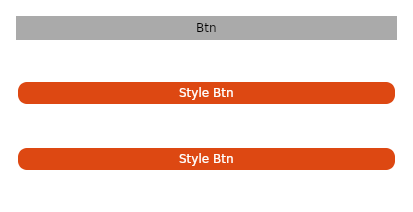
所有窗口代码 <Window xmlns="https://github.com/avaloniaui" xmlns:x="http://schemas.microsoft.com/winfx/2006/xaml" xmlns:vm="clr-namespace:Wind1.ViewModels;assembly=Wind1" xmlns:d="http://schemas.microsoft.com/expression/blend/2008" xmlns:mc="http://schemas.openxmlformats.org/markup-compatibility/2006" mc:Ignorable="d" d:DesignWidth="800" d:DesignHeight="450" x:Class="Wind1.Views.MainWindow" Icon="/Assets/avalonia-logo.ico" Title="Wind1"> <Window.Styles> <Style Selector="Button.btn /template/ ContentPresenter"> <Setter Property="CornerRadius" Value="10" /> </Style> <Style Selector="Button.btn"> <Setter Property="Foreground" Value="#FFFFFFFF" /> <Setter Property="BorderThickness" Value="2" /> <Setter Property="Background" Value="#FFDD4812" /> <Setter Property="BorderBrush" Value="#FFFFFFFF" /> </Style> <Style Selector="Button:pointerover.btn /template/ ContentPresenter"> <Setter Property="BorderBrush" Value="#FFDD4812" /> </Style> </Window.Styles> <StackPanel> <Button Margin="20" Content="Btn" /> <Button Margin="20" Classes="btn" Content="Style Btn" /> <Button Margin="20" Classes="btn" Content="Style Btn" /> </StackPanel> </Window>
另一个有趣的样式示例标准复选框如下所示:

改进的复选框类似于android(略)

一点魔术 <Window.Styles> <Style Selector = "CheckBox.uberbox"> <Setter Property = "Template"> <Setter.Value> <ControlTemplate> <Grid> <Border Background = "# b0b0b0" Padding = "5" BorderBrush = "# 303030" CornerRadius = "5"> <Grid> <Grid Classes = "unchecked" ColumnDefinitions = "Auto, Auto"> <Border Width = "20" Height = "20" Background = "Blue" CornerRadius = "5" /> <TextBlock FontWeight = "Bold" Margin = "5,0,0,0" Grid.Column = "1"> 0FF </TextBlock> </Grid> <Grid Classes = "checked" ColumnDefinitions = "Auto, Auto"> <Border Grid.Column = "1" Width = "20" Height = "20" Background = "Red" CornerRadius = "5" /> <TextBlock FontWeight = "Bold" Margin = "0,0,5,0"> ON </TextBlock> </Grid> </Grid> </Border> <Border Classes = "fade" Background = "White" CornerRadius = "5" /> </Grid> </ControlTemplate> </Setter.Value> </Setter> </Style> <Style Selector = "CheckBox.uberbox / template / Grid.checked"> <Setter Property = "Opacity" Value = "0" /> </Style> <Style Selector = "CheckBox.uberbox: checked / template / Grid.checked"> <Setter Property = "Opacity" Value = "1" /> </Style> <Style Selector = "CheckBox.uberbox: checked / template / Grid.unchecked"> <Setter Property = "Opacity" Value = "0" /> </Style> <Style Selector = "CheckBox.uberbox / template / Border.fade"> <Setter Property = "Opacity" Value = "0" /> </Style> <Style Selector = "CheckBox.uberbox: pointerover / template / Border.fade"> <Setter Property = "Opacity" Value = "0.2" /> </Style> </Window.Styles> <StackPanel> <CheckBox Classes = "uberbox" Margin = "10" /> </StackPanel>
在哪里使用样式
样式可以在窗口中使用(就像我们在上面的示例中所做的那样),
并且在整个应用程序内(然后样式将在所有窗口中应用)。
为此,请将样式添加到
App.xaml文件中
<Application.Styles> <StyleInclude Source = "avares: //Avalonia.Themes.Default/DefaultTheme.xaml" /> <StyleInclude Source = "avares: //Avalonia.Themes.Default/Accents/BaseLight.xaml" /> <Style Selector = "Button"> <Setter Property = "Background" Value = "Blue"> </Setter> </Style> </Application.Styles>
更大的分离
随着代码的复杂化,我们不再希望将样式保留在窗口布局内,而是希望将它们放在单独的文件中:
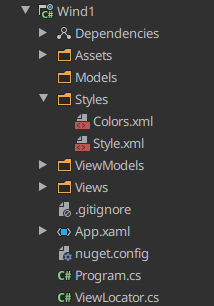
为此,请创建Styles目录,然后以xml或xaml文件的形式在其中添加样式,并添加名称空间:
<Styles xmlns = "https://github.com/avaloniaui" xmlns: x = "http://schemas.microsoft.com/winfx/2006/xaml" xmlns: sys = "clr-namespace: System; assembly = netstandard"> <Style Selector = "Button / template / ContentPresenter"> <Setter Property = "CornerRadius" Value = "10" /> </Style> <Style Selector = "Button"> <Setter Property = "Foreground" Value = "# FFFFFFFF" /> <Setter Property = "BorderThickness" Value = "2" /> <Setter Property = "Background" Value = "# FFDD4812" /> <Setter Property = "BorderBrush" Value = "# FFFFFFFF" /> </Style> <Style Selector = "Button: pointerover / template / ContentPresenter"> <Setter Property = "BorderBrush" Value = "# FFDD4812" /> </Style> </Styles>
将新资源添加到项目文件(* .csproj):
<AvaloniaResource Include = "Styles \ **" />
并使用
StyleInclude标签连接它们
<Window.Styles> <StyleInclude Source = "/ Styles / Style.xml" /> </Window.Styles>
但是有时候这还不够,我想将样式放在一个单独的dll中,以便在我的所有项目中使用。
为此,创建一个ClassLibrary并作为avaloina资源提供对我们将来文件的支持:
<ItemGroup> <AvaloniaResource Include="**\*.xaml"> <SubType>Designer</SubType> </AvaloniaResource> </ItemGroup> <ItemGroup> <AvaloniaResource Include="**\*.xml"> <SubType>Designer</SubType> </AvaloniaResource> </ItemGroup>
现在,将已经熟悉的Styles.xml和另外2个新文件添加到项目中:
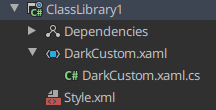
在xaml文件中,您必须指定名称空间及其所属的类,以及必需资源的连接:
<Styles xmlns = "https://github.com/avaloniaui" xmlns: x = "http://schemas.microsoft.com/winfx/2006/xaml" x: Class = "ClassLibrary1.DarkCustom"> <StyleInclude Source = "avares: //ClassLibrary1/Style.xml" /> </Styles>
在cs文件中,我们定义这是一种样式,仅此而已:
namespace ClassLibrary1 { public class DarkCustom: Styles { } }
将依赖项添加到我们的库中,然后重新连接样式,并使用
StyleInclude和
<Window.Styles> <StyleInclude Source = "avares: //ClassLibrary1/DarkCustom.xaml" /> </Window.Styles>
一些更有用的东西
请务必查看官方的《 Avalonia风格指南》(
此处 )
您可以在此处获得有关如何为元素编写样式的基本想法(
此处 )
如果您没有时间/渴望创建自己的样式,则可以使用此出色的样式生成器(
在此处 )
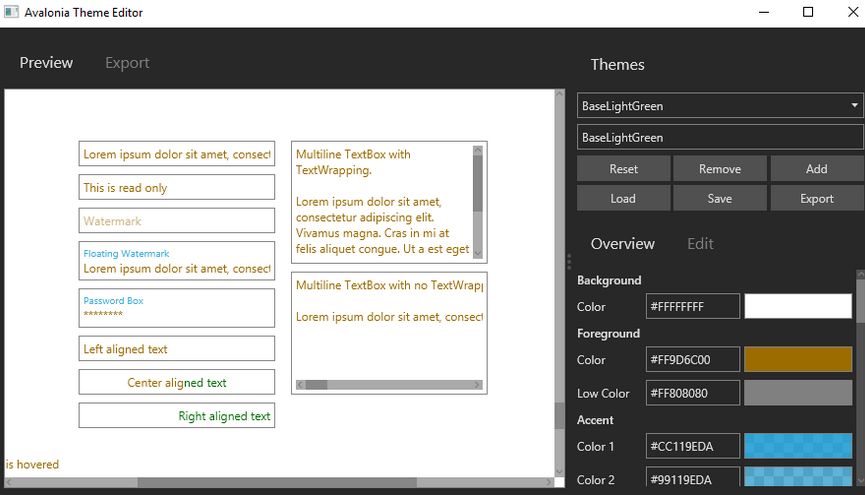
我想说谢谢
Forkeve Kekekeks worldbeater